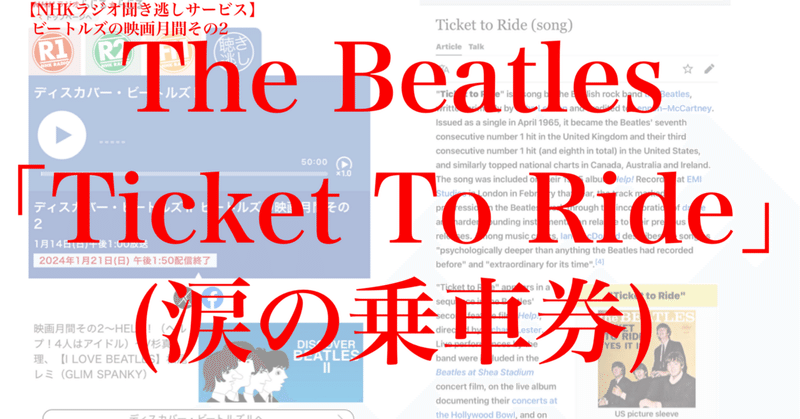
ラジオ生活:ディスカバー・ビートルズ II・ビートルズの映画月間その2・The Beatles「Ticket To Ride」
聞き逃しサービス2024/01/14 放送
ディスカバー・ビートルズ II
ビートルズの映画月間その2
HELP!(ヘルプ!4人はアイドル)
〜
〜
「Ticket To Ride」(涙の乗車券)
The Beatles
(3分2秒)
〜
開始より31分34秒頃 (終了より18分26秒前頃)
〜
〜
配信終了2024/01/21 13:50
(すでに配信終了してます)
番組情報
Google検索 URL>
https://www.google.co.jp/search?tbm=vid&hl=ja&source=hp&biw=&bih=&q=The_Beatles+Ticket_To_Ride
Bing検索> https://www.bing.com/videos/search?q=The_Beatles+Ticket_To_Ride
TheBeatles.com> https://www.thebeatles.com/ticket-ride
「Ticket To Ride」(涙の乗車券)
Wikipedia EN(英語版)> https://en.m.wikipedia.org/wiki/Ticket_to_Ride_(song)
〜
"Ticket to Ride" is a song by the English rock band the Beatles, written primarily by John Lennon and credited to Lennon–McCartney. Issued as a single in April 1965, it became the Beatles' seventh consecutive number 1 hit in the United Kingdom and their third consecutive number 1 hit (and eighth in total) in the United States, and similarly topped national charts in Canada, Australia and Ireland. The song was included on their 1965 album Help! Recorded at EMI Studios in London in February that year, the track marked a progression in the Beatles' work through the incorporation of drone and harder-sounding instrumentation relative to their previous releases. Among music critics, Ian MacDonald describes the song as "psychologically deeper than anything the Beatles had recorded before" and "extraordinary for its time".
"Ticket to Ride" appears in a sequence in the Beatles' second feature film, Help!, directed by Richard Lester. Live performances by the band were included in the Beatles at Shea Stadium concert film, on the live album documenting their concerts at the Hollywood Bowl, and on the 1996 Anthology 2 box set. In 1969, "Ticket to Ride" was covered by The Carpenters, whose version peaked at number 54 on the Billboard Hot 100.
…
【Composition】
"Ticket to Ride" was primarily written by John Lennon, and credited to Lennon–McCartney. In 1965, Lennon claimed that the song was "three-quarters mine and Paul [McCartney] changed it a bit. He said let's alter the tune." However, speaking in 1980, Lennon said that McCartney's contribution was limited to "the way Ringo [Starr] played the drums" on the recording. In his 1997 authorised biography, Paul McCartney contradicts this, providing an account more similar to Lennon's 1965 assessment: "we sat down and wrote it together … give him 60 percent of it … we sat down together and worked on that for a full three-hour songwriting session."
The song is written in the key of A major. The structure of the composition is in an expanded variation of the AABA pop song format, with eight bars of verse and eight bars of chorus forming the A section, and a nine-bar primary bridge forming the B section. The sustained A chord over the verses creates an implied drone common in Indian music and supports a melody that author Ian MacDonald terms "raga-like".
The song's coda features a change of tempo. In the view of musicologist Walter Everett, the latter section marks a progression on previous Beatles songs that similarly revisit aspects of a composition when ending with a coda. In the case of "Ticket to Ride", the section consists of a repeated refrain similar to the last line of the chorus ("My baby don't care"), played over a constant A major chord and set to the double-time rhythm used in the bridge. Lennon said this closing section was one of his "favourite bits" in the song. He also claimed that "Ticket to Ride" was the first heavy metal record ever made. According to MacDonald, the track's heavy sound may have been influenced by Lennon and George Harrison's first encounter with LSD, the precise date for which varies among Beatles biographers. Author Simon Philo calls the song "avant-garde masquerading as pop".
…
…
〜[Excerpted from above wikipedia]
〜[上記wikipediaの日本語翻訳は次の通り。翻訳にはアプリ「DeepL」を使用。]
"チケット・トゥ・ライド "は、イギリスのロックバンド、ビートルズの楽曲で、主にジョン・レノンが作曲し、レノン=マッカートニーがクレジットされている。1965年4月にシングルとして発売されたこの曲は、ビートルズにとってイギリスで7作連続、アメリカで3作連続(通算8作目)のナンバー1ヒットとなり、カナダ、オーストラリア、アイルランドでも同様に全米チャートのトップを飾った。1965年のアルバム『Help』に収録!同年2月にロンドンのEMIスタジオでレコーディングされたこの曲は、ドローンやハードなサウンドの楽器を取り入れることで、それまでのビートルズの作品から一歩前進した。音楽評論家のイアン・マクドナルドは、この曲を「ビートルズがそれまでに録音したどの曲よりも心理的に深い」「当時としては異例」と評している。
チケット・トゥ・ライド」は、リチャード・レスター監督によるビートルズ2作目の長編映画『ヘルプ!』のシークエンスに登場する。ビートルズのライブ演奏は、コンサート・フィルム『Beatles at Shea Stadium』、ハリウッド・ボウルでのコンサートを記録したライブ・アルバム、1996年の『Anthology 2』ボックス・セットに収録されている。1969年、「チケット・トゥ・ライド」はカーペンターズによってカヴァーされ、そのヴァージョンはビルボード・ホット100で54位を記録した。
…
【作曲】
「チケット・トゥ・ライド」は主にジョン・レノンが作曲し、レノン=マッカートニーにクレジットされている。1965年、レノンはこの曲は「4分の3が僕の曲で、ポール(・マッカートニー)が少し変えたんだ。彼は曲を変えようと言ったんだ」。しかし1980年、レノンはマッカートニーの貢献はレコーディングでの「リンゴ(・スター)のドラムの叩き方」に限られていたと語っている。ポール・マッカートニーは1997年に出版した自伝の中で、レノンの1965年の評価に近い説明をし、これに反論している:「一緒に座って書いたんだ......60パーセントは彼に......一緒に座って、3時間みっちり曲作りに取り組んだんだ」。
この曲はイ長調で書かれている。8小節のヴァースと8小節のコーラスがAセクションを形成し、9小節の一次ブリッジがBセクションを形成する。詩の上で持続するAの和音は、インド音楽によく見られる暗黙のドローンを生み出し、作者のイアン・マクドナルドが「ラガ風」と呼ぶメロディーを支えている。
曲のコーダではテンポが変化する。音楽学者ウォルター・エヴェレットの見解によれば、コーダで終わるときに同じように曲の側面を再検討するビートルズの過去の曲は、後者のセクションで進展している。Ticket to Ride」の場合、このセクションは、サビの最後の行(「My baby don't care」)に似たリフレインの繰り返しで構成され、一定のイ長調のコードで演奏され、ブリッジで使われたダブルタイムのリズムにセットされている。レノンは、このエンディング・セクションはこの曲の中で「お気に入りの部分」のひとつだと語っている。彼はまた、"Ticket to Ride "は史上初のヘヴィ・メタル・レコードだと主張している。マクドナルドによれば、この曲のヘヴィなサウンドは、レノンとジョージ・ハリスンが初めてLSDに出会ったことに影響された可能性があるという。著者のサイモン・ファイロは、この曲を「ポップスの仮面をかぶったアヴァンギャルド」と呼んでいる。
…
…
〜
この記事が気に入ったらサポートをしてみませんか?
